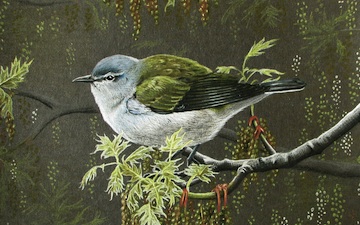The Tennessee Warbler, Oreothlypis peregrina, is a New World warbler. It breeds in northern North America across Canada and the northern USA. It ismigratory, wintering in southern Central America and northern Colombia and Venezuela, with a few stragglers going as far south as Ecuador. It is a very rare vagrant to western Europe. This bird was named from a specimen collected in Tennessee where it may appear during migration.
The Tennessee Warbler is 11.5 cm long and weighs 8.5 g. The breeding male is brown above and white below. The head is gray with a white supercilium and black eye stripe.
Females are duller, with a less contrasted head and yellow-tinged under-parts. Non-breeding and young birds are similar to the female, with first-winter birds being particularly yellow below.
The song is a series of musical notes and trills. The call is a sharp sit.
These birds feed on insects in summer, and numbers vary with the availability of Spruce Budworm. In winter they will also eat berries[1] and nectar.
The breeding habitat is coniferous or mixed woodland, especially spruce. Tennessee Warblers nest on the ground, laying 4-7 eggs in a cup nest.
(From Wikipedia, 6 October 2011)
Despite its misleading name, the Tennessee warbler neither breeds nor over-winters in the state of Tennessee. This species got its name when the first specimen collected had the misfortune of being shot by Alexander Wilson in 1832. This unlucky individual happened to be passing through Tennessee near the Cumberland River in the middle of its long migration between the Canadian boreal forest and the tropical forests of Mexico and Central America. A more apt name for this species might be the “Coffee Warbler” since it often over-winters in coffee plantations in Latin America. Whatever its name, it distinguishes itself through its behavioral versatility and unique specializations.
Even after Wilson described the Tennessee warbler, its breeding habits remained a mystery until 1901, when the first nests were discovered in Canada. We now know their breeding range stretches across the boreal forests of Canada from British Colombia to Quebec and New Brunswick. When nesting, this warbler ventures into the United States only in the forests of the upper Midwest (Minnesota and Michigan) and the northernmost parts of the Northeast (Maine, New Hampshire, Vermont, and the Adirondacks of New York). Throughout its breeding range, this warbler is associated with boreal forests, usually coniferous but often mixed, ranging in age from early successional to mature.
Populations of this species can fluctuate dramatically from year to year, reaching their highest densities -(up to 610 pairs per square kilometer)- in forests with outbreaks of the spruce budworm. Local population increases seem to be the result of abundant food as new birds are attracted to the area. Even with the additional birds, budworm outbreaks allow breeding warblers to increase their clutch size (the number of eggs per nesting attempt). Clutch size for Tennessee warblers varies from three to eight eggs. The incubation period ranges from seven to 12 days and time to fledging after hatching is 11 to 12 days. This ground-nesting species commonly conceals its nests in mossy hummocks at the base of small shrubs and trees, or in upturned stumps. It rarely attempts a second nest in a season, but will double brood after losing a nest to predators.
For post-breeding birds, the arrival of cold weather can be unpredictable; this prompts early migration. Some adult Tennessee warblers appear south of the breeding grounds as early as mid-July. This long-distance traveler is restless enough to regularly leave the breeding grounds before completing molt, showing an exceptional tendency to molt and migrate simultaneously. This is unusual, especially for warblers, as most birds replace worn feathers in the late summer before departing on migration. Growing new feathers for molt requires substantial food energy, as does migration, so most bird species separate these activities temporally. Generally, fall migration for Tennessee warblers is protracted with the peak of migration in August. Adults usually leave first, followed by first-year birds, which sometimes depart as late as October.
Tennessee warblers join mixed-species flocks during migration, primarily foraging in woody habitats. The general migration route is back and forth across the central and eastern United States from the Mississippi Valley to the Atlantic coast. They fly across the Gulf of Mexico between the Yucatan peninsula and the southern United States coastline from Florida to Texas. On the southward journey, Tennessee warblers move more regularly to the western side of this track than during the northward trek, when birds are more common east of the Appalachians. Throughout the migration route, abundances can be highly variable from year to year.
Tennessee warblers have exhibited a wide range of social behaviors on their non-breeding grounds, from defending individual flowering trees to highly gregarious mixed-species flocks with lots of conspecifics. This behavioral flexibility is not well understood but may be linked to the dependability of food resources. For example, flowering in individual Inga trees is fairly short-lived, consequently eachInga species has a distinctive flowering pattern across the landscape. Gregarious foraging behavior may help Tennessee Warblers track and exploit these flowering events.
Tennessee warbler populations seem to be healthy throughout their range. Their range does not significantly overlap the Brown-headed Cowbird’s, so nest parasitism is rare. Possible threats to this species include use of pesticides, especially spraying to control spruce budworm outbreaks, collisions with human structures during migration, and habitat degradation, in particular, intensification of coffee management practices on the non-breeding grounds. Encouraging greater use of a diversity of native shade trees on coffee farms may be of particular benefit for this species.
(From The Smithsonian National Zoo Online, http://nationalzoo.si.edu, 6 October 2011)





